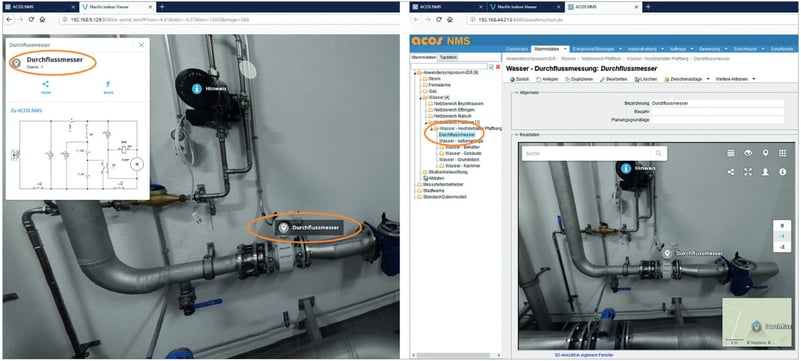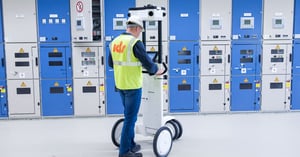Cologne-based energy supplier RheinEnergie improves plant maintenance through an ambitious 3D visualization project carried out by IDS and powered by NavVis.
One German energy supplier kicked off a bold new strategy last Summer, commissioning the 3D visualization of a power plant in the city of Westhoven and laying down the foundations for an industrial digital twin.
RheinEnergie entrusted smart grids specialist IDS with the scanning project in July 2018, which proved so successful that it's now being expanded to another 30 installations throughout 2019.
Using an indoor mobile mapping system (IMMS) from NavVis – in this instance the NavVis M3 – the specialists from IDS were able to scan two floors, each measuring 236.5 square meters in just a matter of hours. The high-quality scanned data was used to create a detailed point cloud, which forms the basis of 2D floorplans, 3D plans, and CAD models.
Every NavVis IMMS comes equipped with six high-resolution cameras and three single-layer scanners. The current benchmark for indoor spatial intelligence is the NavVis M6 IMMS, which also has a LIDAR scanner that enables cutting-edge SLAM (simultaneous localization and mapping) algorithms for indoor data capture, including NavVis 6D SLAM.
3D images optimize documentation and maintenance planning
 Users can view the scanned data in either NavVis IndoorViewer (left) or the ACOS NMS resource information system (right), where additional resource information is available.
Users can view the scanned data in either NavVis IndoorViewer (left) or the ACOS NMS resource information system (right), where additional resource information is available.
Employees at RheinEnergie can now view 360° images of the power plant in NavVis IndoorViewer, a web-based application that combines realistic 3D visualization of buildings with an intuitive interface.
The 3D model is also accessible through the bespoke ACOS NMS Asset Information System from IDS. Information such as instructions, circuit diagrams, and plant-specific details can be called up and viewed in the model.
In effect, users of either application can virtually walk through each room and seamlessly switch from floor to floor. From any desired location, they can take precise measurements, study points of interest, and plan detailed renovations. And all of this can be managed remotely, without leaving the comfort of their desk.
Questions concerning specialized tools, cable routing, and space optimization, for example, can now be answered directly from the central office.
RheinEnergie believes this will improve the documentation of its plants and optimize the maintenance process. "We first became aware of the innovative solution at the IDS in-house exhibition," says Michael Schmidt, Project Manager at RheinEnergie.
"The possibility of precisely documenting the systems is particularly interesting. We can further optimize our maintenance process by combining the 3D images with the operating resources information system."
A winning partnership between IDS and NavVis
RheinEnergie and IDS are now busy scanning another 30 installations in 2019. Moreover, the team at IDS are delighted with the positive impact the NavVis IMMS has made to their wider business.
"We are using the NavVis indoor mobile mapping system to scan the facilities of our customers, and usually those are facilities containing highly safety-relevant and cost-intensive equipment," says Frank Vollmann, Product Manager at IDS.
"There we capture the indoor spatial data, which is then visualized using the NavVis IndoorViewer, which creates a lot of business value for us as we integrated it into our software," he continues.
"This allows us to connect the data from the 3D building model in NavVis IndoorViewer with the available asset data, which is managed within our facility information system."
Image credits: IDS GmbH


